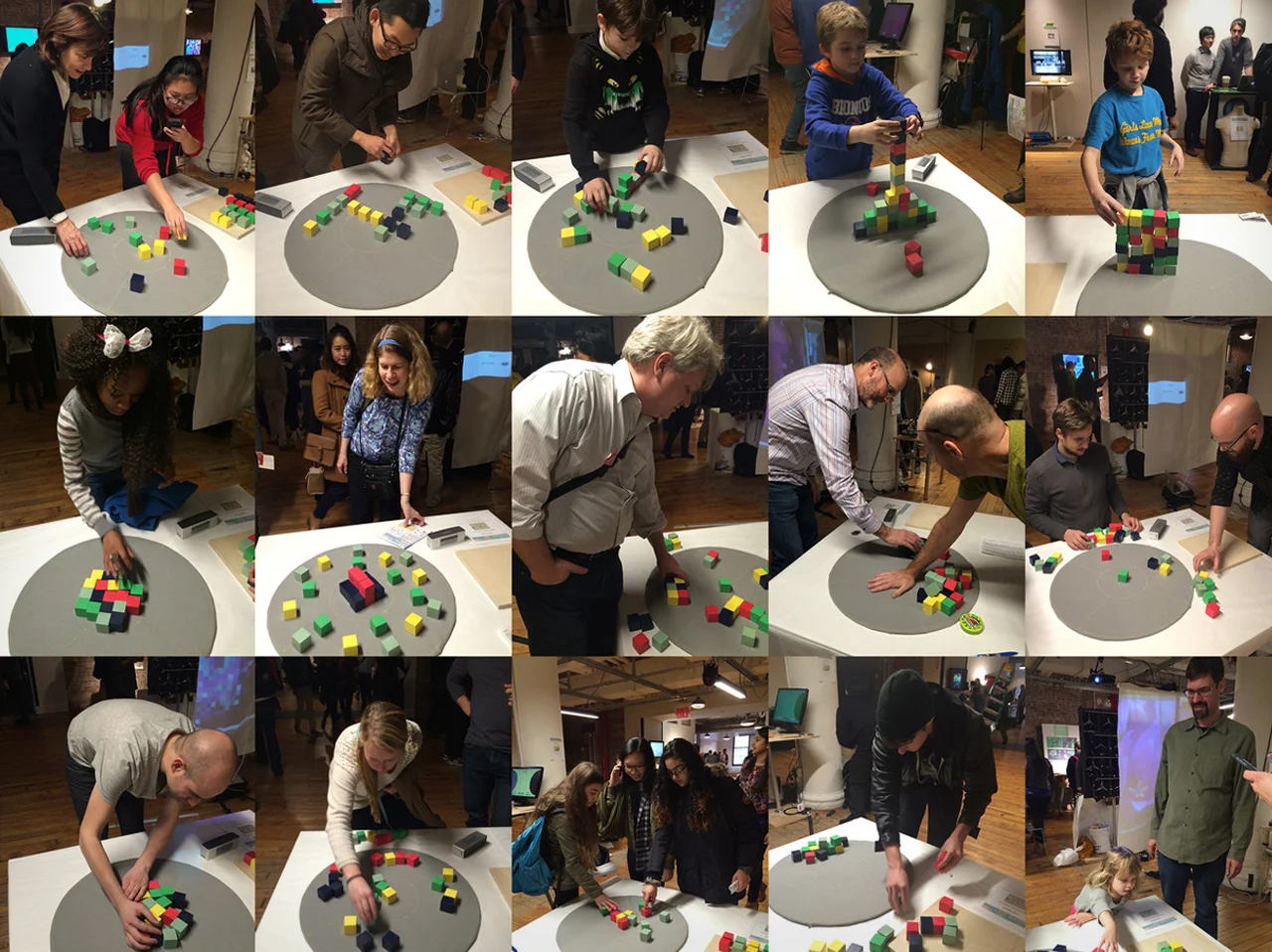FELT SOUND
Physical Sound Interface
PROJECT BRIEF
Press : Makezine December 2014
Role : Interface Design, Programming, Fabrication
Team member : Magdalena Kovarik (Interface Design / Fabrication)
November - December 2014
FELT SOUND is a sound installation you can build and feel the sounds while you play with colorful wooden blocks on an interactive mat.
There are a bunch of colorful wooden blocks on the top of a felt mat. While you place, stack, and knock down those blocks, you can make countless combinations of sounds in your own ways. Several sensors are embedded inside of the felt mat, and each sensor generates different types of sounds. As you place more blocks, more sound will be added in harmonious ways. The felt mat is specifically designed to turn an everyday object - the felt mat- into an unexpected sound playground for those who participate.
INSPIRATION
We would like to do some kind of modular structure which is so easily understandable and intuitive in it’s appliance that it is not necessary to explain the user how to deal with it. Furthermore, no electronic components should be visible and the appearance should be contemporary, simple and limited to the minimum.
The first idea was building wooden blocks just like what children play. Every block has a different sound by stacking up or just put it down on the ground. We think that the way that people can simply play with blocks and led to make sounds is making some limited ground that looks like carpet on which the user can freely interact with the blocks. The block itself are not electronic at all, only the ground is reacting.
There is a carpet where you can play with the sound cubes on. The carpet is divided into different sections. First into quarters – every quarter has a different beat. Once you put/or throw a piece on the quarter you turn its beat over a pressure sensor on. Second the carpet is divided into four concentric circles. Depending on which circle you put a brick, the beat changes. Also depending on how many pieces you put on the ring, the pressure sensor reacts on the weight and changes too.
CREATING SOUNDS
WITH ARDUINO AND PROCESSING
First of all, I used Firmata library which allows me to control an Arduino board from Processing. After setting up the Firmata, I used the minim library in Processing and make different sounds depending on values of different pressure sensors. While messing around with the minim, I also knew that I should only use 8 or 16 bits depth sound files because of seeing the error as below.
PROTOTYPE FABRICATION
Phase 1. Trying Different FSRs
Since we want to make different sounds by sensing the weight of blocks, we decided to use FSR and used the store-bought large square sensors at first. and we've got several hand-made FSRs from our kind ITPers. We tried all of them but the sensing values is too different from one and another. the one that made with copper plate was not that sensitive at all, and the other one made with velostat pressure sensor was really hard to make it conductive because the area that copper tape attached was too narrow. On the other hand, the sensor that covered with cotton and sewn up with conductive thread inside (made by Roy) was really sensitive so that I didn't even have to put pressure on it.
After trying to make sounds by using different FSRs, we decided to make our own FSRs, since we should make its shape like circles or rings separately. And we are trying to make really good chord with various sounds.
Phase 2. Making our own FSRs & several prototypes
In order to make customized FSRs, we used materials such as conductive fabric, velostat, aluminum foil, etc. We made various types of FSRs to check the sensor values and stability so that we can decide which one is the most appropriate for our project. In each sensor, we used four different types of sounds which are xylophone, flute, violin, glockenspiel.
FIRST USER TEST
Feedback from the test :
- Handmade FSRs totally worked when people stacked up the blocks and other elements.
- The users liked to listen all of the sounds and play with multiple blocks and sensors but also wanted to hear them separately
- The users wanted to add more blocks or elements to make more different sounds.
- The users expected to hear the different sounds right after they change the status.
SECOND USER TEST
Phase 3. Making Final Product & 2nd Play Test
From the first play test, we realized that people want to play with more blocks and make various sounds. And users also wanted to make harmonious sounds while they are staking up or placing different spots and expect an immediate response.
We prepared 30 wooden blocks, made sensors as round shape, and set different types of delay so that we can check what kind of interaction is the most users prefer.
Painting blocks
We thought that making colorful blocks is another way of engaging people to interact with it. We decided to paint blocks in 6 different colors since we have 5 types of sensors. (However, it makes people to think that each color has different effect with each other.)
THIRD USER TEST
Colorful Blocks Let People More Actively Engaged And Stay Longer Than Before.
What if users stack up all of 30 blocks on one sensor spot?
We thought about the cases that people can make, and we decided to change the speed of sounds more faster and faster if users place the blocks in one spot. And at the time when all blocks stack up, made sounds stop. People liked the idea.
FINAL INTERFACE
















